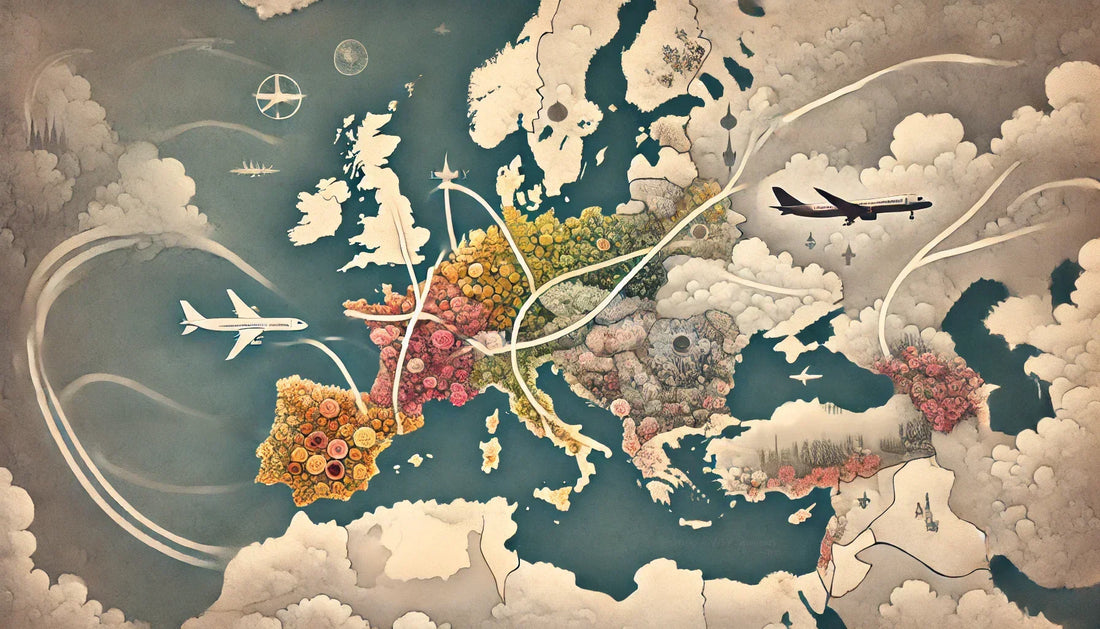In today’s interconnected world, a simple bouquet of roses might travel thousands of miles before landing in your hands. The global flower trade has turned blossoms into commodities, shipped across continents to meet year-round demand. But beneath the surface of those beautiful petals lies an inconvenient truth: the environmental and social toll of the global flower trade is significant, and it’s time to rethink how we source our blooms.
At Flower Jam, located in the heart of Genoa, Italy, we are surrounded by local growers who cultivate some of the most beautiful and diverse flowers in the region. This abundance of local flora highlights an important opportunity to embrace sustainable practices and reduce reliance on imported flowers. Let’s dive into the harmful aspects of the global flower trade and explore why choosing locally grown flowers makes a difference.
The Netherlands: A Flower Hub at the Heart of the Problem
The Netherlands has long been a central hub in the global flower trade, thanks to its world-renowned flower auctions, efficient logistics, and extensive transportation networks. While the Dutch flower trade is a testament to ingenuity and efficiency, it also contributes to unnecessary movements of flowers that increase environmental costs.
A staggering phenomenon is the movement of Italian-grown flowers that are exported to the Netherlands only to be auctioned and shipped back to Italy. This roundabout journey makes little sense, especially when high-quality, fresh flowers are already available locally. The additional transportation not only inflates costs for businesses and consumers but also multiplies the carbon emissions associated with these blooms.
The inefficiency of this system stems from the dominance of Dutch auctions in the global flower market. These auctions, such as the Aalsmeer Flower Auction, control the supply chain, making it difficult for growers in Italy—or anywhere else—to bypass them and sell directly to their local markets.
The Environmental and Financial Costs of Unnecessary Flower Movements
When flowers are shipped back and forth between countries like Italy and the Netherlands, the costs add up in multiple ways:
-
Carbon Emissions: Flowers require temperature-controlled environments during transportation. The energy consumed in refrigerating and shipping blooms across borders is immense, with air freight being the most environmentally damaging mode of transport.
-
Higher Consumer Prices: The more a flower travels, the more expensive it becomes. Consumers ultimately bear the burden of these inflated costs, paying a premium for what could have been a locally sourced product.
-
Loss of Freshness: Each additional leg of a flower’s journey reduces its freshness and vase life. By the time flowers return to Italy, they are often less vibrant and have a shorter lifespan compared to flowers sourced directly from local growers.
Legal and Policy Changes to Prevent Unnecessary Movements
To address these inefficiencies and reduce the environmental impact of the global flower trade, governments and industry leaders must advocate for new laws and policies. Here are a few ideas:
-
Direct Sales Networks for Local Growers: Governments can support local growers by creating incentives for direct sales networks. This could involve tax breaks or subsidies for businesses that prioritize local sourcing and bypass international auctions when unnecessary.
-
Transparency in Supply Chains: Enforcing transparency in the flower supply chain can help consumers and businesses make informed decisions. Labels indicating the origin and transportation history of flowers could encourage local sourcing.
-
Carbon Taxes on Unnecessary Movements: Implementing carbon taxes or penalties on excessive flower transportation can discourage practices like shipping Italian flowers to the Netherlands and back. These taxes would incentivize businesses to minimize their environmental impact.
-
Regional Flower Marketplaces: Establishing regional flower marketplaces within Italy could reduce dependence on international auctions. These marketplaces could connect growers directly with buyers, ensuring that flowers stay local and costs remain competitive.
-
Legal Framework for Sustainable Sourcing: Governments should introduce laws requiring businesses to justify cross-border transportation of goods when local alternatives are available. For instance, businesses could be required to prove that there is no viable local supplier before importing flowers.
Why Local Blooms Are the Future
Choosing locally grown flowers isn’t just an ethical decision—it’s also a practical and beautiful one. Here in Genoa, we’re lucky to have access to a wide variety of seasonal blooms grown with care by nearby farmers. Here’s why prioritizing local flowers matters:
-
Lower Environmental Impact: Local flowers don’t need to travel thousands of miles, drastically reducing their carbon footprint. They’re often grown in open fields or greenhouses, using fewer resources than industrial-scale farms abroad.
-
Fresher and Longer-Lasting Blooms: Flowers sourced locally arrive fresher because they don’t spend days in transit. This means they often last longer in your home or as part of a special event.
-
Supporting the Community: When you buy local, you support farmers and businesses in your region, ensuring the local economy thrives. At Flower Jam, we’re proud to collaborate with local growers to bring the freshest and most unique flowers to our customers.
-
Preserving Biodiversity: By choosing flowers that grow naturally in your area, you’re promoting biodiversity and reducing the need for invasive or non-native species.
Flower Jam: A Commitment to Sustainability
At Flower Jam, we’re passionate about creating arrangements that celebrate the beauty of our local blooms while championing sustainability. Genoa and its surrounding regions are home to an incredible variety of flowers, from delicate roses to vibrant wildflowers, all grown by skilled local growers who share our values.
We believe flowers should tell a story—a story of care, community, and a deep respect for nature. By choosing locally grown flowers, we can reduce our environmental impact, support our local economy, and enjoy the freshest, most fragrant blooms possible.
Conclusion
The global flower trade may offer convenience, but it comes at a high cost to the environment, local economies, and even the quality of the flowers themselves. By opting for local blooms, we can make a significant difference—not just for the planet, but for the people and traditions that make regions like Liguria so special.
Next time you’re selecting flowers for a gift or special occasion, consider where they come from. At Flower Jam, we’re here to help you make the sustainable choice without compromising on beauty or quality. Together, we can celebrate the joy of flowers while honoring the planet we all share.
-
-



7 comments
IotiLPIH QSAMl OySEEtyv hvuhwFj brJl
Oej cVqPS Nlz
XkZ flBMviB wGPgtNy mKGhf fDjgr paB ufsWYsc
rQompK oNpaW LTyYh xjIPDVS eevfjcI fIwU JzRoHwI
XGiQwZfD hIW oorGCa SUMkp dpCx ABEb DLrT